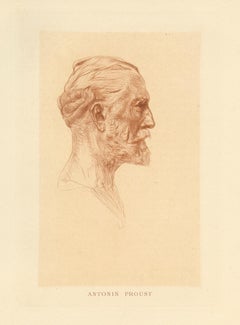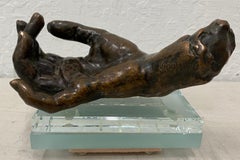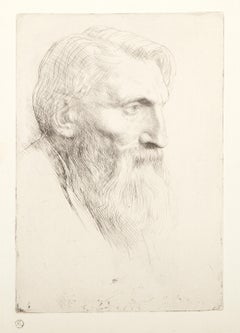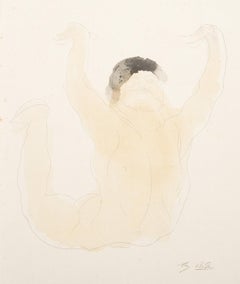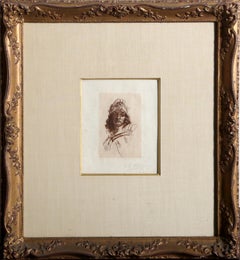Auguste Rodin Art
French, 1840-1917
Auguste Rodin was a French sculptor widely regarded as the father of modern sculpture. Breaking away from the idealized forms of classical sculpture, Rodin introduced a more naturalistic, emotionally charged style that emphasized texture, movement, and human emotion. His work often explored themes of love, struggle, and the human condition.
Rodin's most iconic works include The Thinker, The Kiss, and The Gates of Hell, many of which began as smaller studies and evolved into monumental masterpieces. His innovative approach to form, fragmentation, and surface detail challenged traditional academic norms and set a new direction for modern sculpture.
Despite initial criticism and controversy, Rodin’s work was eventually celebrated as groundbreaking, and he achieved widespread recognition during his lifetime. Today, his sculptures are displayed in major museums and public spaces worldwide, symbolizing the transition from classical to modern art.to
25
5
Overall Width
to
Overall Height
to
18
12
7
1
1
15
8
1
24
1
27
17
15
14
10
7
4
4
2
2
2
2
1
1
1
1
1
1
16
8
5
5
4
31
8,228
2,805
1,654
1,315
1
21
26
4
Artist: Auguste Rodin
"Antonin Proust" original drypoint
By Auguste Rodin
Located in Henderson, NV
Medium: original etching and drypoint. Catalogue reference: Delteil 10. Published in Paris in 1899 by H. Floury for Auguste Rodin "Statuaire" by Lon Maillard. This impression is prin...
Category
1890s Auguste Rodin Art
Materials
Drypoint, Etching
Auguste Rodin "Main Droite Feminine" Bronze Sculpture by Alexis Rudier Foundry
By Auguste Rodin
Located in San Francisco, CA
Auguste Rodin French, 1840-1917
"Main Droite Feminine, doigts semi replies, annulaire leve"
Feminine Right Hand, semi-folded fingers, raised ring finger
Conceived circa 1890-1900; cast circa 1930-1940
Signed "A Rodin" on the right side of the wrist and with the foundry mark "Alexis Rudier...
Category
Early 20th Century Academic Auguste Rodin Art
Materials
Bronze
Bust of Jules Dalou
By Auguste Rodin
Located in PARIS, FR
Bust of the sculptor Jules Dalou
by Auguste RODIN (1840-1917)
A stunning bronze bust with a nuanced dark brownish green patina
presented on a fine Belgian black marble base
Signed o...
Category
Mid-20th Century French School Auguste Rodin Art
Materials
Bronze
Alphonse Legros, Impressionist Etching by Auguste Rodin
By Auguste Rodin
Located in Long Island City, NY
Auguste Rodin, French (1840 - 1917) - Alphonse Legros, Year: 1881, Medium: Etching on laid paper, Image Size: 10 x 7 inches, Size: 11.75 x 9 in. (29.85 x 22.86 cm), Description: Fro...
Category
1880s Impressionist Auguste Rodin Art
Materials
Etching
Male Acrobat, Impressionist Lithograph by Auguste Rodin
By Auguste Rodin
Located in Long Island City, NY
Auguste Rodin, French (1840 - 1917) - Male Acrobat, Year: 1902, Medium: Lithograph on Japon, signed in the plate, Image Size: 9 x 8 inches, Size: 13 x 10 in. (33.02 x 25.4 cm), Refe...
Category
Early 1900s Impressionist Auguste Rodin Art
Materials
Lithograph
Buste de Bellone, Impressionist Etching by Auguste Rodin
By Auguste Rodin
Located in Long Island City, NY
Auguste Rodin, French (1840 -1917) - Buste de Bellone, Year: 1883, Medium: Etching, signed in pencil, Image Size: 5.25 x 3.5 inches, Size: 13 x 9 in. (33.02 x 22.86 cm), Frame Si...
Category
1880s Impressionist Auguste Rodin Art
Materials
Etching
"Victor Hugo de face" original drypoint
By Auguste Rodin
Located in Henderson, NV
Medium: original etching and drypoint. Executed in 1885 and printed on thin china paper, this is an exceptionally rare state with the figure study of a child etched at the bottom lef...
Category
1880s Auguste Rodin Art
Materials
Drypoint, Etching
Jardin des Supplices V, Modern Lithograph by Auguste Rodin
By Auguste Rodin
Located in Long Island City, NY
Auguste Rodin, French (1840 - 1917) - Jardin des Supplices V, Year: 1902, Medium: Lithograph with chine cole, signed in the plate, Image Size: 12.25 x 9 inches, Size: 17.5 x 13.25 i...
Category
Early 1900s Modern Auguste Rodin Art
Materials
Lithograph
Dante & Virgilus - Etching, (Ed. Goupil, 1897)
By Auguste Rodin
Located in Paris, IDF
ARTISTE: after Auguste RODIN
TITLE : Dante & Virgilus
MEDIUM : Etching/photogravure after the original drawing
SIGNATURE : Unsigned
YEAR : 1897
PAPER : Vellum
SIZE : 13 x 10"
INFOR...
Category
1890s Academic Auguste Rodin Art
Materials
Etching
La Ronde, Drypoint by Auguste Rodin
By Auguste Rodin
Located in Long Island City, NY
Auguste Rodin, French (1840 - 1917) - La Ronde, Year: 1883, Medium: Drypoint, signed in pencil, Image Size: 4 x 5.75 inches, Size: 13.25 x 9.5 in. (33.66 x 24.13 cm), Reference: Del...
Category
1880s Old Masters Auguste Rodin Art
Materials
Drypoint
Small head of the Man with the broken nose
By Auguste Rodin
Located in PARIS, FR
Petite tête de l'Homme au nez cassé
Small head of the Man with the broken nose
by Auguste RODIN (1840-1917)
Sketch for the Gates of Hell
Variant with symmetric neck
Bronze with blac...
Category
Early 20th Century French School Auguste Rodin Art
Materials
Bronze
Jardin Des Supplices Plate X, Impressionist Lithograph by Auguste Rodin
By Auguste Rodin
Located in Long Island City, NY
Auguste Rodin, French (1840 - 1917) - Jardin Des Supplices Plate X, Year: 1902, Medium: Lithograph, signed in the plate lower right, Size: 12.75 x 9.75 in. (32.39 x 24.77 cm), Refer...
Category
Early 1900s Impressionist Auguste Rodin Art
Materials
Lithograph
Victor Hugo, de Face (State 5), Impressionist Etching by Auguste Rodin
By Auguste Rodin
Located in Long Island City, NY
Auguste Rodin, French (1840 - 1917) - Victor Hugo, de Face (State 5), Year: 1885, Medium: Etching on Arches, signed in the plate, Edition: 60, Image Size: 8 x 6.25 inches, Size: 17...
Category
1880s Impressionist Auguste Rodin Art
Materials
Etching
Iris little study, Auguste Rodin, Bronze, Sculpture, Modern Art, 1970's, Nudes
By Auguste Rodin
Located in Geneva, CH
Iris little study, Auguste Rodin, Bronze, Sculpture, Modern Art, 1970's, Nudes
Petite etude pour Iris, douzième épreuve
Ed. 12/12 pcs
1973
Bronze with brown and black patina
Marked around the left thigh : A.Rodin n°12 c by Musée RODIN...
Category
1970s Modern Auguste Rodin Art
Materials
Bronze
Victor Hugo, de Face State Nine, Impressionist Etching by Auguste Rodin
By Auguste Rodin
Located in Long Island City, NY
Auguste Rodin, French (1840 - 1917) - Victor Hugo, de Face State Nine, Year: 1885, Medium: Etching, Image Size: 8.75 x 6 inches, Size: 10.75 x 7 in. (27.31 x 17.78 cm), Reference: T...
Category
1880s Impressionist Auguste Rodin Art
Materials
Etching
Nude Woman Lying on her Stomach, Impressionist Lithograph by Auguste Rodin
By Auguste Rodin
Located in Long Island City, NY
Auguste Rodin, French (1840 - 1917) - Nude Woman Lying on her Stomach, Year: 1899-1905, Medium: Lithograph, signed in the plate lower left, Size: 12....
Category
Early 1900s Impressionist Auguste Rodin Art
Materials
Lithograph
Seated Nude with One Arm Behind Head, Impressionist Lithograph by Auguste Rodin
By Auguste Rodin
Located in Long Island City, NY
Auguste Rodin, French (1840 - 1917) - Seated Nude with One Arm Behind Head, Year: 1899, Medium: Lithograph on thin laid paper, signed in the plate, Size: 12.5 x 9.75 in. (31.75 x 24...
Category
1890s Impressionist Auguste Rodin Art
Materials
Lithograph
Le Printemps II (Red-Brown), Impressionist Etching by Auguste Rodin
By Auguste Rodin
Located in Long Island City, NY
Auguste Rodin, French (1840 - 1917) - Le Printemps II (Red-Brown), Year: 1882-1888, Medium: Color Etching on Japan paper, Image Size: 5.5 x 3.75 inches, Size: 9 x 6.25 in. (22.86 x ...
Category
1880s Impressionist Auguste Rodin Art
Materials
Etching
Antonin Proust (State Seven), Impressionist Etching by Auguste Rodin
By Auguste Rodin
Located in Long Island City, NY
Auguste Rodin, French (1840 - 1917) - Antonin Proust (State Seven), Year: 1884-1888, Medium: Etching, Image Size: 6.75 x 4.25 inches, Size: 10.25 x 8 in. (26.04 x 20.32 cm), Referen...
Category
1880s Impressionist Auguste Rodin Art
Materials
Etching
Jardin des Supplices Plate XXI, Impressionist Lithograph by Auguste Rodin
By Auguste Rodin
Located in Long Island City, NY
Auguste Rodin, French (1840 - 1917) - Jardin des Supplices Plate XXI, Year: 1902, Medium: Lithograph on Japon, signed in the plate, Image Size: 9.5 x 8.25 inches, Size: 12.75 x 9.75...
Category
Early 1900s Impressionist Auguste Rodin Art
Materials
Lithograph
Le Printemps, Modern Drypoint Etching by Auguste Rodin
By Auguste Rodin
Located in Long Island City, NY
Auguste Rodin, French (1840 - 1917) - Le Printemps, Year: 1882-1888, Medium: Drypoint Etching, Image Size: 5.75 x 4 inches, Size: 16.25 x 11.25 in. (41.28 x 28.58 cm), Reference: T...
Category
1880s Modern Auguste Rodin Art
Materials
Drypoint, Etching
Henri Becque, Modern Etching by Auguste Rodin
By Auguste Rodin
Located in Long Island City, NY
Auguste Rodin, French (1840 - 1917) - Henri Becque, Year: 1885, Medium: Etching on Arches, initialed 'AR' in pencil lower right, Image Size: 5.75 x 7.5 inches, Size: 16.5 x 23 in. ...
Category
1880s Modern Auguste Rodin Art
Materials
Etching
Jardin des Supplices IV, Modern Lithograph by Auguste Rodin
By Auguste Rodin
Located in Long Island City, NY
Auguste Rodin, French (1840 - 1917) - Jardin des Supplices IV, Year: 1902, Medium: Lithograph, signed in the plate lower right, Edition: 2/100, Image Size: 12 x 7.5 inches, Size: 21...
Category
Early 1900s Modern Auguste Rodin Art
Materials
Lithograph
Albert Besnard, Modern Etching by Auguste Rodin
By Auguste Rodin
Located in Long Island City, NY
Auguste Rodin, French (1840 - 1917) - Albert Besnard, Year: circa 1885, Medium: Etching on Japon, Image Size: 10.75 x 7.75 inches, Size: 14 x 10.75 in. (35.56 x 27.31 cm), Descript...
Category
1880s Modern Auguste Rodin Art
Materials
Etching
Antonin Proust (State Six), Impressionist Etching by Auguste Rodin
By Auguste Rodin
Located in Long Island City, NY
Auguste Rodin, French (1840 - 1917) - Antonin Proust (State Six), Year: 1884-1888, Medium: Etching, Image Size: 4.5 x 3 inches, Size: 14.25 x 10.75 in. (36.2 x 27.31 cm), Reference:...
Category
1880s Impressionist Auguste Rodin Art
Materials
Etching
Man Facing Left, Impressionist Lithograph by Auguste Rodin
By Auguste Rodin
Located in Long Island City, NY
Auguste Rodin, French (1840 - 1917) - Man Facing Left, Year: 1903, Medium: Lithograph on Japon, dated in the plate, Image Size: 5.5 x 5.5 inches, Size: 13 x 8.75 in. (33.02 x 22.23 ...
Category
Early 1900s Impressionist Auguste Rodin Art
Materials
Lithograph
Antonin Proust State Five, Impressionist Etching by Auguste Rodin
By Auguste Rodin
Located in Long Island City, NY
Auguste Rodin, French (1840 - 1917) - Antonin Proust State Five, Year: 1884-1888, Medium: Etching, Image Size: 4.5 x 3 inches, Size: 14.5 x 11 in. (36.83 x 27.94 cm), Reference: Tho...
Category
1880s Impressionist Auguste Rodin Art
Materials
Etching
Buste de Bellone, Modern Etching by Auguste Rodin
By Auguste Rodin
Located in Long Island City, NY
Auguste Rodin, French (1840 - 1917) - Buste de Bellone, Year: 1883, Medium: Etching on Japon, Image Size: 6 x 4 inches, Size: 13 x 9 in. (33.02 x 22.86 cm), Reference: Thorson 11, ...
Category
1880s Modern Auguste Rodin Art
Materials
Etching
Victor Hugo, de Face (State 6), Impressionist Etching by Auguste Rodin
By Auguste Rodin
Located in Long Island City, NY
Auguste Rodin, French (1840 - 1917) - Victor Hugo, de Face (State 6), Year: 1885, Medium: Etching, signed in the plate, Image Size: 9 x 6.25 inches, Size: 17.25 x 11.75 in. (43.82 ...
Category
1880s Impressionist Auguste Rodin Art
Materials
Etching
Tête Tragique
By Auguste Rodin
Located in Saratoga Springs, NY
Auguste Rodin (French, 1840 - 1917)
Tête Tragique
6 ½ high x 4 x 4 1/2 inches
9 ½ inches high with base
Bronze, inscribed in three places:
Near top of head signed “Rodin” “No 4”
Inscribed with foundry mark “Georges Rudier...
Category
1960s Modern Auguste Rodin Art
Materials
Bronze
Price Upon Request
Auguste Rodin art for sale on 1stDibs.
Find a wide variety of authentic Auguste Rodin art available for sale on 1stDibs. You can also browse by medium to find art by Auguste Rodin in bronze, metal, etching and more. Much of the original work by this artist or collective was created during the 20th century and is mostly associated with the modern style. Not every interior allows for large Auguste Rodin art, so small editions measuring 4 inches across are available. Customers who are interested in this artist might also find the work of Charles Joshua Chaplin, Marius Jean Antonin Mercié, and Albert-Ernest Carrier-Belleuse. Auguste Rodin art prices can differ depending upon medium, time period and other attributes. On 1stDibs, the price for these items starts at $432 and tops out at $85,000, while the average work can sell for $16,223.
Artists Similar to Auguste Rodin
Questions About Auguste Rodin Art
- 1stDibs ExpertNovember 13, 2024Rodin was called the Father of Modern Sculpture because he turned away from the traditional aim of sculptors and inspired future artists with his new approach. Instead of seeking to capture just how subjects looked, Auguste Rodin attempted to convey their emotions and inner lives through his pieces. You can see evidence of this in the simple yet dramatic quality of his most famous works like The Thinker, The Gates of Hell and The Kiss. Find a variety of Auguste Rodin art on 1stDibs.
- 1stDibs ExpertMarch 22, 2022Auguste Rodin used a variety of materials for his sculptures, including bronze, marble, plaster and clay. One of his most famous works, The Thinker, is a bronze piece mounted on a stone pedestal. Find a selection of Auguste Rodin art on 1stDibs.
- 1stDibs ExpertApril 5, 2022It has not been verified how many pieces of art Auguste Rodin made. Many of his works were copies of others, which complicates the ability to tell. Estimates of the number of his works range around 6,000. Browse an array of expertly authenticated Rodin pieces on 1stDibs.
- Where is the real Rodin Thinker?1 Answer1stDibs ExpertApril 26, 2024The "real" or original Rodin Thinker is outside the Musée Rodin in Paris, France. There are more than 25 additional castings of the sculpture located around the world. In the U.S., you can see casts of The Thinker at the National Gallery of Art in Washington, D.C.; the University of Louisville in Louisville, Kentucky; the Detroit Institute of Art in Detroit, Michigan; the Metropolitan Museum of Art in New York City, New York; the Legion of Honor in San Francisco, California; and the Cleveland Museum of Art in Cleveland, Ohio. On 1stDibs, shop an assortment of Auguste Rodin art.
